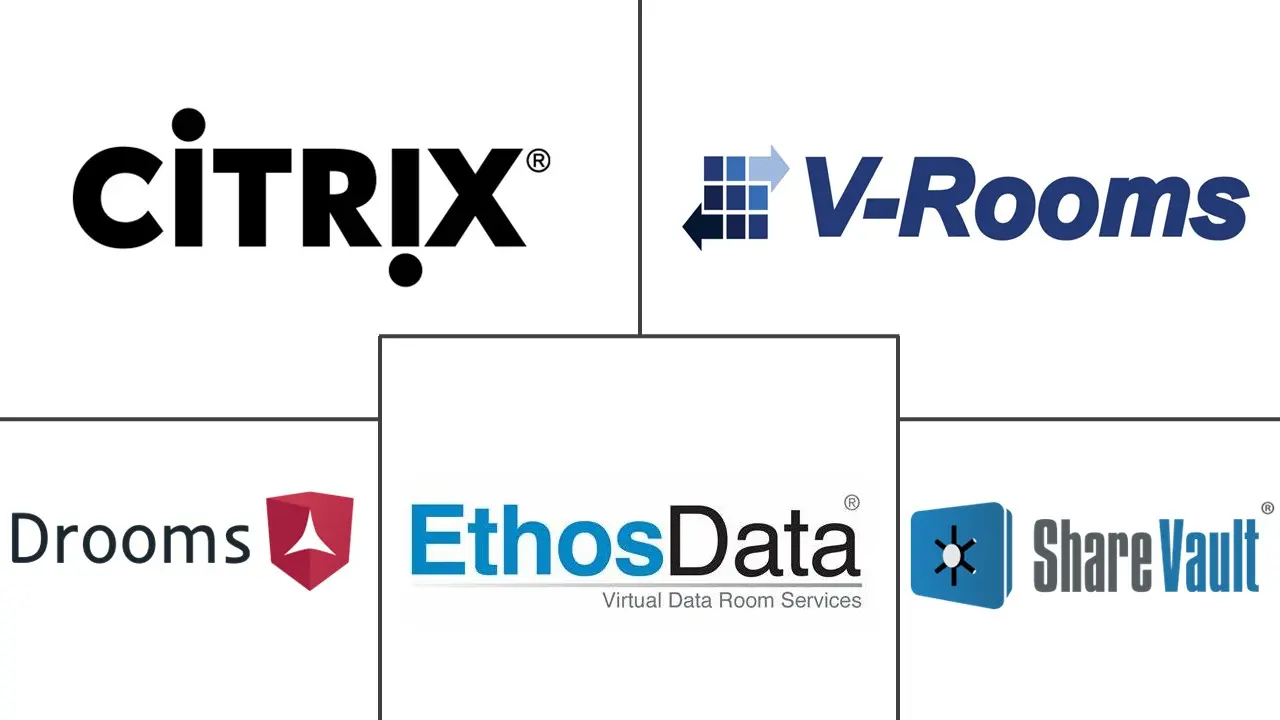Virtual Data Room Market Size and Share
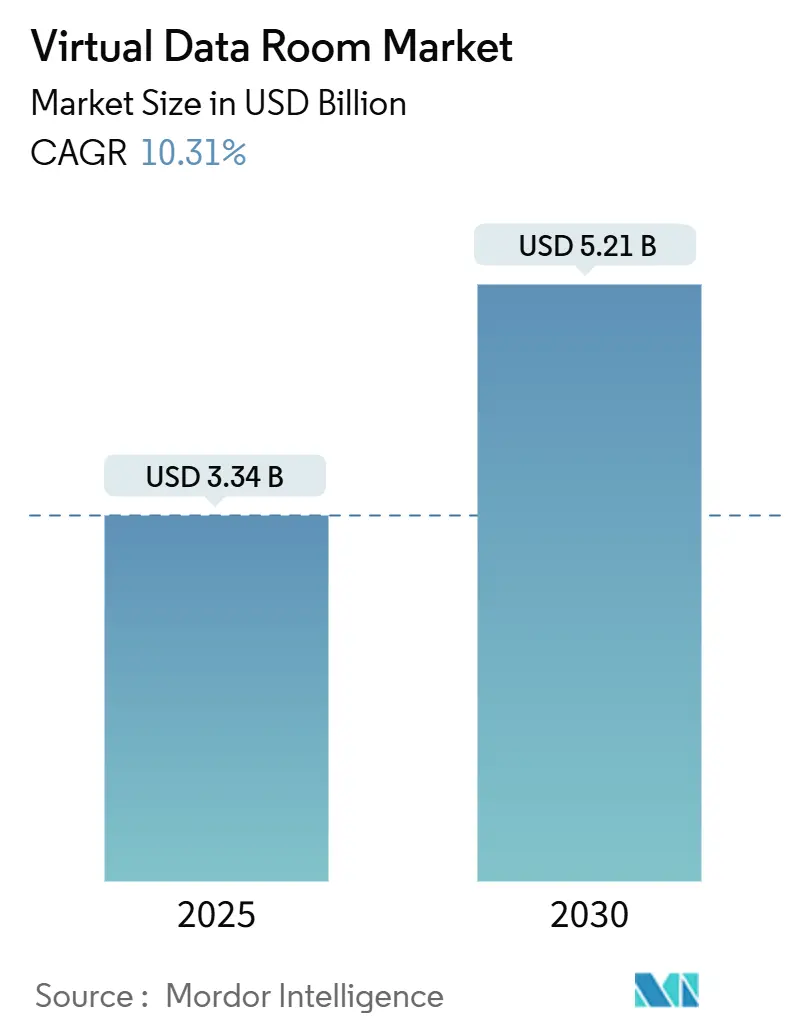
Virtual Data Room Market Analysis by Mordor Intelligence
The virtual data room market size is valued at USD 3.34 billion in 2025 and is forecast to reach USD 5.21 billion by 2030, registering a 10.31% CAGR. Demand is expanding as enterprises accelerate the digitization of sensitive documents to meet tightening regulatory mandates and to streamline cross-border transactions.[1]European Commission, “EU Data Act Adopted,” ec.europa.eu Deals are becoming larger and more complex, pushing corporates to adopt secure, AI-enabled platforms for due diligence and post-merger integration. China’s Network Data Security Management Regulations and the EU Data Act are compelling providers to localize storage and embed granular audit trails, reinforcing market expansion in both EMEA and Asia-Pacific. Large enterprises still generate most revenue, yet SMEs are the fastest-growing buyers because subscription‐based models have fallen to USD 400–1,000 per month, removing historical cost barriers. Industry-specific functionality—such as eCTD viewers for life-sciences dossiers—adds further momentum in healthcare and biotech, the fastest-growing end-user vertical at 15.2% CAGR.
Key Report Takeaways
- By component, software led with 68% revenue share in 2024; services are projected to expand at a 13.9% CAGR through 2030.
- By deployment mode, cloud captured 83% of the virtual data room market share in 2024 while advancing at a 14.6% CAGR to 2030.
- By organization size, large enterprises accounted for 72% of the virtual data room market size in 2024; SMEs are poised to grow at 15.8% CAGR between 2025–2030.
- By business function, legal & compliance dominated with 38% share in 2024; intellectual property management is forecast to post the fastest CAGR at 16.9% over the outlook period.
- By end-user industry, BFSI held 31% of 2024 revenue, whereas healthcare & life sciences will expand at a 15.2% CAGR to 2030.
- By region, North America remained the largest market with 41% share in 2024; Asia-Pacific is the fastest-growing region at 14.4% CAGR through 2030.
Global Virtual Data Room Market Trends and Insights
Drivers Impact Analysis
| Driver | (~) % Impact on CAGR Forecast | Geographic Relevance | Impact Timeline |
|---|---|---|---|
| Accelerated Cross-border M&A Requiring Multi-jurisdiction Compliance | +2.8% | Global, with concentration in North America & EMEA | Medium term (2-4 years) |
| Demand for Remote Audit & Board Collaboration in Regulated Industries | +1.9% | Global, particularly BFSI and Healthcare sectors | Short term (≤ 2 years) |
| Rise of IP-centric Transactions in Life Sciences & TMT | +2.1% | North America, Europe, Asia-Pacific core markets | Medium term (2-4 years) |
| Adoption of Integrated AI/ML Analytics within VDR Platforms | +1.7% | Global, with early adoption in developed markets | Long term (≥ 4 years) |
| Migration from Siloed FTP/Email to Secure SaaS-based Data Rooms | +1.5% | Global, with accelerated adoption in emerging markets | Short term (≤ 2 years) |
| Source: Mordor Intelligence | |||
Accelerated Cross-border M&A Requiring Multi-jurisdiction Compliance
Cross-border deal values rose 5% in 2024 even as volumes slipped, highlighting the shift toward high-stakes transactions that must satisfy overlapping antitrust, foreign investment, and data-privacy laws.[2]Vestbee, “2024 CEE Private Equity Report,” vestbee.com New merger-control thresholds in the UAE and stricter FDI filters in Germany illustrate the maze of approvals buyers confront. India’s Digital Personal Data Protection Act requires explicit consent and country-specific processing clauses, further complicating information flows. Vendors are embedding data-sovereignty toggles and real-time regulatory checklists so deal teams can map document location, user access, and retention periods by jurisdiction.
Demand for Remote Audit & Board Collaboration in Regulated Industries
Financial institutions in Asia-Pacific are accelerating cloud migration to cut costs and modernize compliance, yet 93% cite difficulty meeting audit demands, fueling investment in secure board portals with immutable logs.[3]The Financial Brand, “Compliance Pain Points in Fintech,” thefinancialbrand.com China’s Data Security Management Measures oblige banks to classify information and document every access event, a mandate now hard-wired into enterprise-grade VDRs. Nasdaq’s patent for subsidiary governance showcases the push for multi-entity data hierarchies that streamline regulator reviews.
Rise of IP-centric Transactions in Life Sciences & TMT
Biotech licensing and AI-driven tech acquisitions hinge on safeguarding lab notebooks, genomic data, code, and patent files. DFIN’s Venue platform delivers HIPAA, GDPR, and SOC 2 Type II compliance together with eCTD viewers, setting a template for sector-specific offerings. Blockchain-anchored permission layers are emerging to secure patent exchanges, while NLP engines screen portfolios of more than 6,000 digital-identity patents for prior-art risk.
Adoption of Integrated AI/ML Analytics within VDR Platforms
Intralinks is embedding large-language-model summarization, clause extraction, and anomaly detection to shorten due-diligence cycles. Debitos introduced AI-powered search that mines unstructured content and automatically tags sensitive items, lifting productivity for distressed-asset traders. Upcoming tools such as ShareVault’s AI Redaction will mask personally identifiable information before files enter deal rooms, supporting privacy-by-design principles.
Restraints Impact Analysis
| Restraint | (~) % Impact on CAGR Forecast | Geographic Relevance | Impact Timeline |
|---|---|---|---|
| Data-Sovereignty Rules Limiting Cross-border Hosting | -1.4% | Global, with particular impact in EU, China, and emerging markets | Medium term (2-4 years) |
| Persistent User Mis-configuration Driving Security Breaches | -0.9% | Global, with higher impact in SME segments | Short term (≤ 2 years) |
| High Subscription Costs for SME One-off Projects | -1.2% | Global, with concentration in emerging markets | Short term (≤ 2 years) |
| Vendor-switching & Commoditization Pressure on Pricing | -0.8% | Mature markets, particularly North America and Europe | Long term (≥ 4 years) |
| Source: Mordor Intelligence | |||
Data-Sovereignty Rules Limiting Cross-border Hosting
Conflicts between the EU’s GDPR and the US CLOUD Act force multinationals to compartmentalize storage or risk enforcement action, driving providers to open regional data centers in Germany, Japan, and Australia. China’s Trusted Data Space blueprint similarly restricts outbound transfers, raising capex for infrastructure duplication. German SMEs must also meet NIS-2 and DORA cybersecurity controls, adding compliance overhead that influences provider selection.
Persistent User Mis-configuration Driving Security Breaches
Advanced permission sets can overwhelm non-technical staff, causing inadvertent exposure. Patent filings for granular, role-based controls underscore the search for user-friendly safeguards that lock down defaults and apply searchable encryption to limit fallout when credentials leak. Providers are rolling out guided setup wizards and real-time permission checkers to cut error rates, a critical adoption lever in the SME segment.
Segment Analysis
By Component: Services Segment Expands amid Software Core
Software anchored 68% of revenue in 2024, underscoring its status as the backbone of the virtual data room market. The services component, however, is scaling faster at 13.9% CAGR as clients seek regulatory consulting, AI analytics, and integration support. Large accounts increasingly bundle platform licenses with workflow-design projects, mirroring SS&C’s revenue uplift to USD 4.84 billion in 2024. Government tenders such as the UK’s USD 6.5 billion G-Cloud 14 are also specifying managed services, validating a shift from pure software delivery to outcome-based engagements.
Demand for premium services rises when transactions span privacy regimes, prompting vendors to position specialized teams that configure data-residency rules, retention schedules, and AI-driven redaction models. As a result, implementation consulting, workflow automation, and on-call compliance advisory are expected to command over 30% of incremental market spend by 2030. The services stream therefore acts as a hedge against price pressure in core licensing, reinforcing revenue diversity for established players.
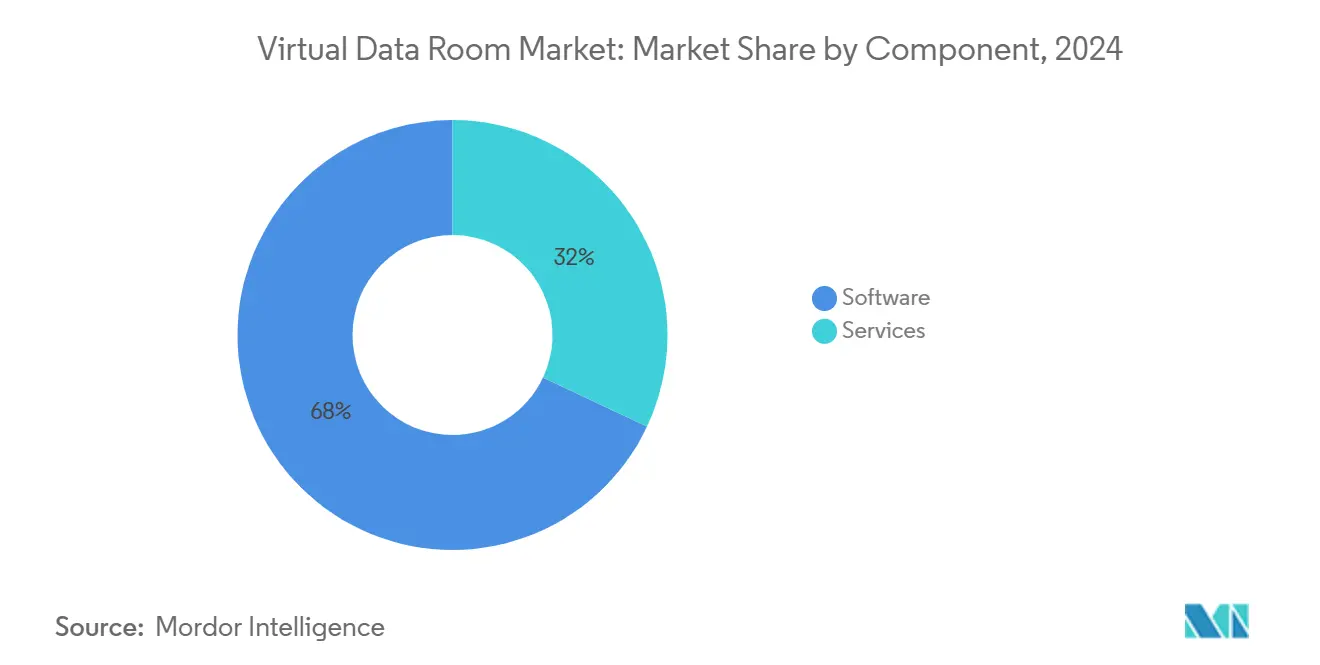
Note: Segment shares of all individual segments available upon report purchase
By Deployment Mode: Cloud Ascendancy with Security Guardrails
Cloud delivery captured 83% of 2024 revenue and exhibits the highest growth pace at 14.6% CAGR, signalling market consensus that hyperscale infrastructure can now satisfy bank-grade controls. Per-gigabyte fees—ranging from USD 60–77 per month—still influence heavy-data users, but flat-rate options at USD 400–1,000 monthly encourage midsize buyers to migrate. Sovereignty clauses are steering some clients to hybrid setups where sensitive archives stay on-premise while analytics compute bursts into the cloud.
Providers invest in multi-tenant encryption and customer-managed keys so that regulators accept cloud as an equivalent or superior control environment. The global build-out of public-cloud regions creates proximity that slices latency while satisfying residency statutes, accelerating adoption in geographically dispersed deal teams. As technological confidence mounts, legacy on-premise installations are expected to shrink below 10% of the virtual data room market by 2030.
By Organization Size: SMEs Accelerate under Flexible Pricing
Large enterprises retained 72% of 2024 spend, yet SMEs will post a 15.8% CAGR to 2030, outpacing every other cohort. Subscription models as low as USD 15 per user per month democratize access, while wizard-based setup trims onboarding to hours rather than weeks. Germany’s Mittelstand illustrates this pivot, where firms adopt VDRs to meet NIS-2 and DORA rules without building costly in-house infrastructure.
Enterprise requirements nevertheless steer innovation. Patented board-portal hierarchies and AI anomaly detection debut in large accounts before filtering to SME packages, creating a virtuous cycle where mass adoption funds further R&D. Occasional-use clients increasingly select virtual data room market size offerings bundled as “transaction packs,” providing fixed-term access without ongoing commitments, a model anticipated to lift SME penetration beyond 30% of active rooms by 2030.
By Business Function: IP Management Gains Momentum
Legal & compliance functions held 38% share in 2024, cementing their role as the anchor use case. Intellectual property management, however, is forecast to grow 16.9% CAGR, reflecting the monetization of patents and data assets in tech and life-sciences deals. Blockchain-secured audit trails and NLP-driven prior-art searches now ship as standard in premium plans, reducing diligence cycles for portfolios exceeding 1,000 patents. Financial management tasks—fundraising, restructurings, and divestitures—continue to fuel steady volume, backed by a projected 2–5% uplift in Americas M&A flows during 2025.
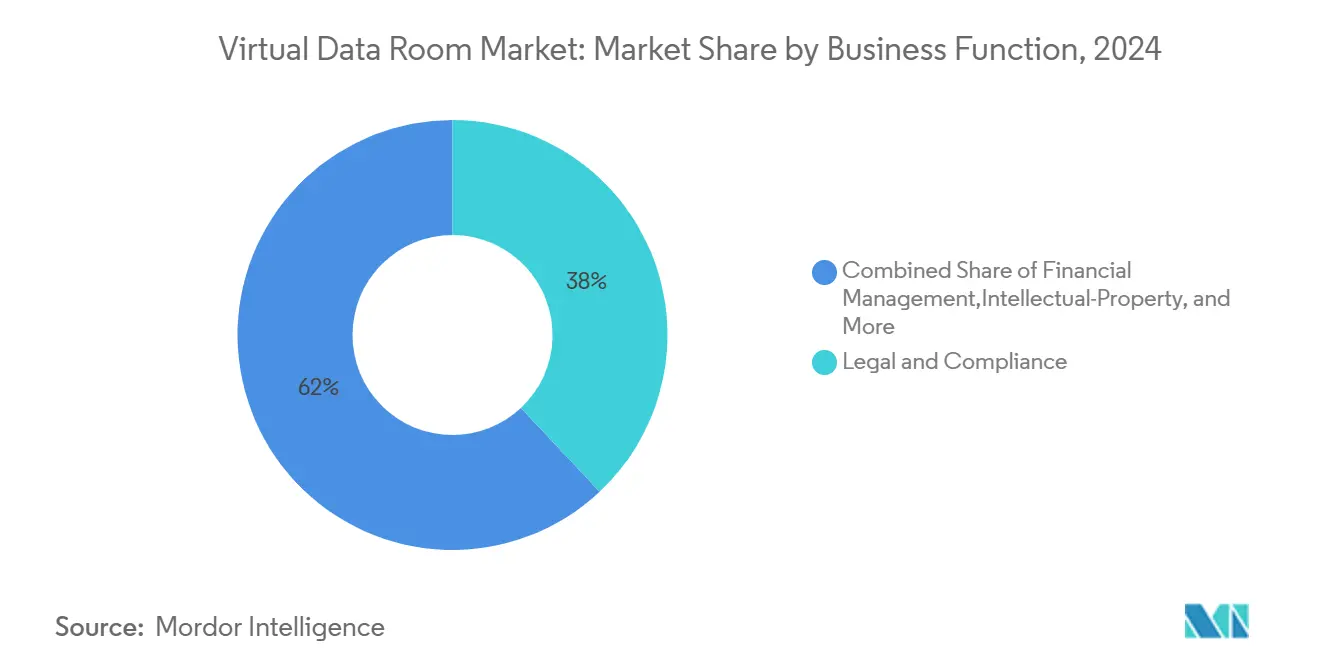
Note: Segment shares of all individual segments available upon report purchase
By End-user Industry: Healthcare & Life Sciences Outpaces BFSI Growth
BFSI occupied the top revenue slot at 31% in 2024 thanks to regulatory intensity and high-value restructurings, yet healthcare & life sciences will expand the fastest at 15.2% CAGR to 2030. Venue’s eCTD viewers and ShareVault’s BIO partnership illustrate the requirement for FDA-ready audit trails and granular role permissions. Government and legal services also present upside, as evidenced by the USD 6.5 billion G-Cloud 14 budget earmarked for secure document services.
Geography Analysis
North America generated 41% of 2024 revenue, supported by deep capital markets, robust private equity activity, and well-defined disclosure laws. The virtual data room market size for the region is buoyed by repeat buyers in energy, healthcare, and technology sectors that execute multi-deal pipelines annually. SS&C’s rise to USD 4.84 billion revenue in 2024 underscores this demand.
Europe is gaining momentum as M&A recoveries accelerate post-pandemic, with expected 10% volume growth in 2025. The EU Data Act adds interoperability obligations that favor vendors with API-rich platforms and in-region storage nodes. Germany’s heightened FDI scrutiny and mid-cap private equity rebound create use cases where VDR-enabled real-time Q&A and redaction speed closing timelines.
Asia-Pacific posts the highest CAGR at 14.4%. China’s Financial Technology Development Plan and data-security regulations compel domestic hosting, prompting global providers to establish joint ventures and sovereign clouds. Japan’s LegalTech-led services for electronics supply chains highlight localized innovation that addresses industry-specific compliance. India’s new data-privacy law drives adoption in tech and pharma cross-border deals, cementing APAC’s role as a growth engine through 2030.
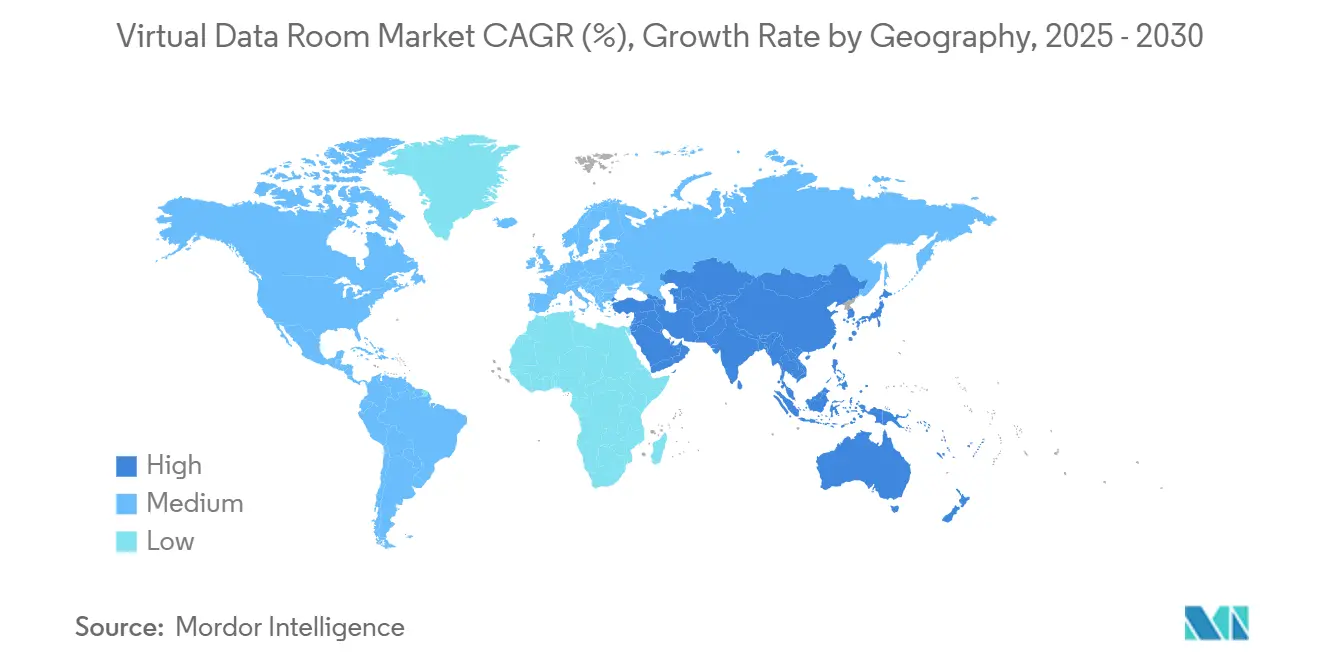
Competitive Landscape
The virtual data room market shows moderate concentration: the top five providers collectively control about 55–60% of global revenue. Leaders defend share through AI feature rollouts, regional data-center expansion, and vertical partnerships. SS&C continues bolt-on acquisitions and cross-selling across fund administration, leveraging Intralinks to upsell data rooms into its investor-services base.
Specialists pursue niche depth. ShareVault tailors life-sciences templates and wins association endorsements such as BIO, embedding itself early in biotech pipelines. Debitos targets non-performing loan exchanges with AI search tuned for distressed-asset documentation. Patent filings reveal defense in depth: Seagate’s searchable encryption and Palantir’s real-time permission engines indicate continuous security R&D.
Pricing pressure remains a threat as commoditization sets in for baseline capabilities. Vendors counter with service bundles, outcome-based pricing, and edge features like AI redaction. Government procurement frameworks such as G-Cloud 14 open large contract pools but demand rigorous certification, influencing roadmaps toward ISO 27001, FedRAMP, and sovereign cloud options.
Virtual Data Room Industry Leaders
-
Vault Rooms Inc.
-
Citrix Systems Inc.
-
Drooms GmbH
-
ShareVault (Pandesa Corporation)
-
EthosData
- *Disclaimer: Major Players sorted in no particular order
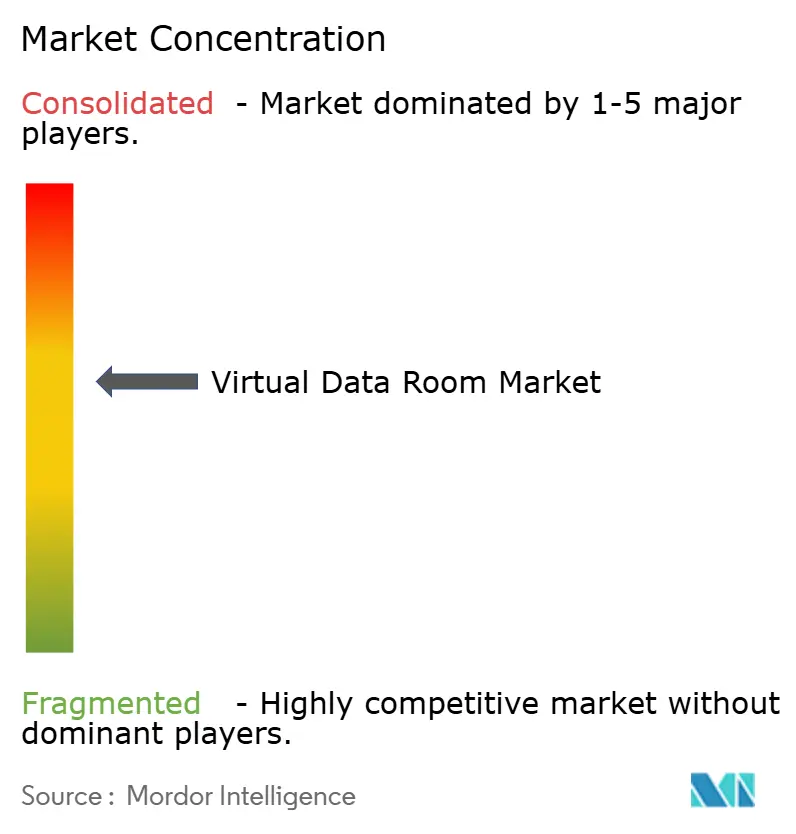
Recent Industry Developments
- June 2025: The People’s Bank of China issued Data Security Management Measures for financial data. VDR suppliers are embedding classification templates and risk-scoring algorithms to attract domestic banks and insurers.
- May 2025: Zhejiang University released a Trusted Data Space architecture under national guidance, prompting vendors to align with technical standards anticipated to become mandatory for cross-industry data circulation.
- January 2025: China enforced the Network Data Security Management Regulations, raising the compliance bar for life-cycle protection. Providers are fast-tracking domestic data centers to preserve deal flow involving Chinese assets.
- December 2024: ShareVault disclosed new European and Asian data centers and a 2025 AI Redaction launch. The move positions the firm to capture sovereignty-conscious clients and automate PII removal at scale.
Research Methodology Framework and Report Scope
Market Definitions and Key Coverage
Our study defines the virtual data room market as the global revenue generated by cloud-based or on-premise software platforms that let multiple authorized parties store, manage, and exchange confidential files in a highly audited environment during events such as mergers and acquisitions, fund-raising, restructurings, litigation, and board or regulatory reviews.
Scope exclusion: generic enterprise file-sharing tools that lack deal-ready audit trails, permission hierarchies, and tamper-proof version control sit outside the market boundary.
Segmentation Overview
- By Component
- Software
- Services
- By Deployment Mode
- Cloud-based
- On-premise
- By Organization Size
- Small and Medium Enterprises (SMEs)
- Large Enterprises
- By Business Function
- Legal and Compliance
- Financial Management (MandA, Fund-raising, Restructuring)
- Intellectual-Property Management
- Sales and Marketing/ Channel Partnerships
- Other Business Function
- By End-user Industry
- BFSI
- IT and Telecom
- Healthcare and Life Sciences
- Government, Public Sector and Legal Services
- Other End-user Industries
- By Geography
- North America
- United States
- Canada
- Mexico
- Europe
- United Kingdom
- Germany
- France
- Rest of Europe
- Asia-Pacific
- China
- Japan
- India
- Rest of Asia-Pacific
- South America
- Brazil
- Argentina
- Rest of South America
- Middle East
- GCC
- Turkey
- Rest of Middle East
- Africa
- South Africa
- Nigeria
- Rest of Africa
- North America
Detailed Research Methodology and Data Validation
Primary Research
Mordor analysts interviewed VDR software architects, data-privacy lawyers, investment-bank deal makers, and IT heads from large enterprises across North America, Europe, and Asia. These discussions clarified average deal rooms opened per transaction, typical page counts, permission-tier depth, and expected annual seat churn, enabling us to fine-tune utilization and pricing assumptions.
Desk Research
We began by mapping the universe of demand using freely accessible, high-trust sources such as the U.S. Securities and Exchange Commission Edgar filings, European Central Bank M&A statistics, and OECD cross-border investment datasets, which signal deal flow and drive VDR uptake. Industry associations like the Association for Corporate Growth and the International Association of Privacy Professionals helped our team track evolving diligence and compliance norms, while patent databases (Questel) and news aggregators (Dow Jones Factiva) flagged technology shifts and vendor moves.
Government cyber-breach reports, trade press interviews, and selected company presentations then anchored baseline adoption rates, average project volumes, and price brackets. This list is illustrative; many further sources were consulted to corroborate figures and close data gaps.
Market-Sizing & Forecasting
A top-down model starts with announced global M&A, equity raising, and bankruptcy filings to derive the potential pool of transactions, which are then multiplied by verified VDR penetration rates and blended average selling price. Bottom-up checks, supplier revenue roll-ups and sampled license counts, validate and, where needed, adjust totals. Core variables include quarterly M&A dollar volume, venture-capital deal counts, average document pages per room, SaaS subscription inflation, regional data-protection fines, and public-cloud price trends. A multivariate regression with these predictors generates the 2025-2030 forecast; scenario analysis captures upside from AI-enabled redaction and downside from slower deal cycles. Any bottom-up shortfall is bridged through calibrated penetration proxies rather than speculative data.
Data Validation & Update Cycle
Our outputs pass three internal review stages, variance checks against independent signals, and a reconciliation call with key interviewees. Models refresh every twelve months, with interim updates triggered by material regulation or macro shocks, and a final analyst pass occurs before each client delivery.
Why Our Virtual Data Room Baseline Commands Reliability
Published market values often diverge because firms choose differing platform scopes, treat services revenue inconsistently, or report aggressive growth paths.
Key gap drivers include: some publishers classify basic file-sharing tools as VDRs, others assume every announced deal uses premium data rooms, and several apply uniform price escalation rather than region-specific ASP trends. Mordor Intelligence reports only platforms meeting stringent audit, watermarking, and permission standards and anchors pricing to verified user invoices. It then revisits the model annually, which narrows volatility.
Benchmark comparison
| Market Size | Anonymized source | Primary gap driver |
|---|---|---|
| USD 3.34 B (2025) | Mordor Intelligence | - |
| USD 2.42 B (2024) | Global Consultancy A | includes basic cloud storage and applies constant 22% CAGR without regional ASP checks |
| USD 2.83 B (2024) | Trade Journal B | rolls legal e-discovery platforms into scope, ignores service revenue, and uses single-source deal counts |
These comparisons show why Mordor's disciplined scope setting, verified variables, and annual refresh yield a balanced, transparent baseline that decision-makers can rely on with confidence.
Key Questions Answered in the Report
What is the projected size of the virtual data room market by 2030?
The virtual data room market is expected to reach USD 5.21 billion by 2030, based on a 10.3% CAGR from its 2025 baseline of USD 3.34 billion.
Which region will grow the fastest over the forecast period?
Asia-Pacific leads with a 14.4% CAGR driven by China’s data-security mandates and a surge in technology and life-sciences M&A.
Why are SMEs adopting VDRs at a higher rate than before?
Subscription pricing starting at USD 15–250 per user monthly and simplified cloud deployment have removed cost and complexity barriers for smaller firms.
How are AI tools reshaping VDR functionality?
Integrated AI performs clause extraction, risk scoring, and automated redaction, cutting diligence time and enhancing compliance for complex transactions.
What is the biggest regulatory driver influencing VDR demand in Europe?
The EU Data Act, effective September 2025, imposes data-sharing and interoperability duties that require secure, auditable platforms.
Which end-user industry is forecast to expand the quickest, and why?
Healthcare & life sciences will grow at 15.2% CAGR because of specialized requirements for clinical trial data, eCTD submissions, and IP licensing.
Page last updated on:
